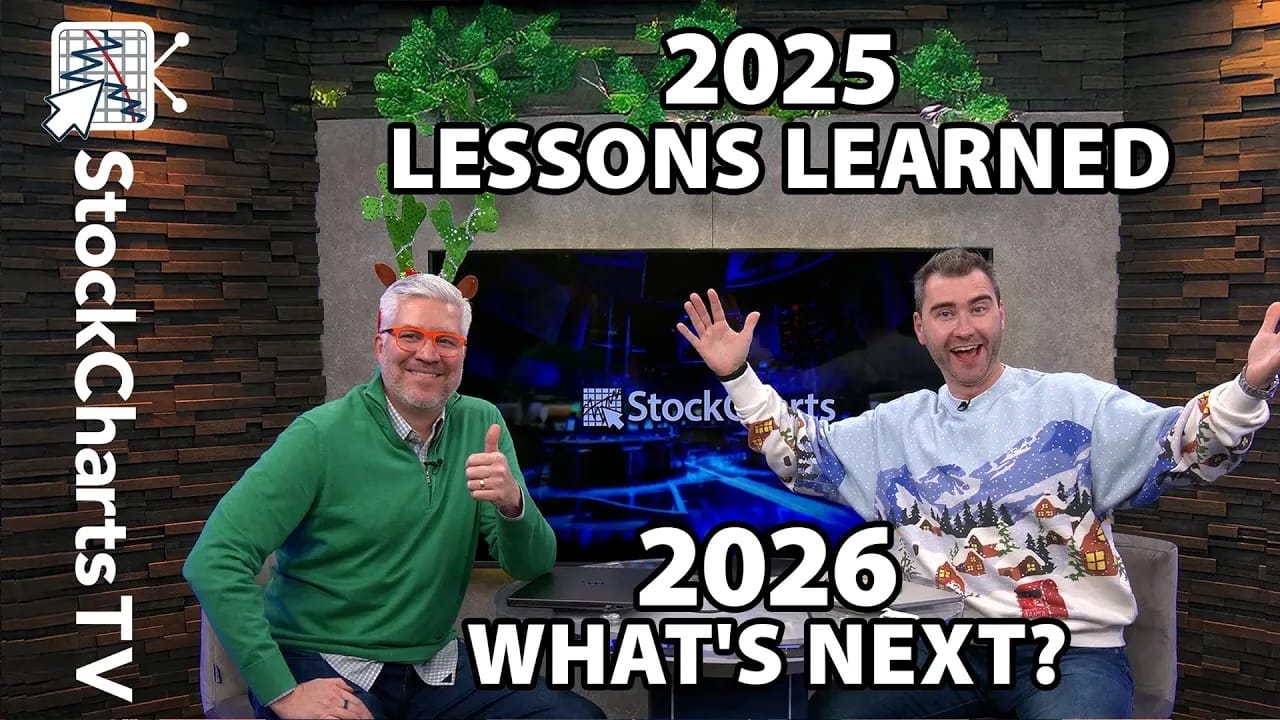TECHS AND SMALL-CAPS SHOW RESILIENCE - SPX HITS LONG TERM REVERSAL ZONE - CHANNEL STILL FALLING FOR SPX - OIL BATTLES SUPPORT - XLE AND OIH ALSO BATTLING SUPPORT - SHANGHAI COMPOSITE BREAKS SUPPORT
TECHS AND SMALL-CAPS SHOW RESILIENCE... Link for todays video. The Nasdaq 100 ETF (QQQQ) and the Russell 2000 ETF (IWM) are showing relative strength this week. Concerns with Greek debt and monetary tightening in China weighed on stocks in early trading, but buyers stepped in after the morning gap and pushed stocks higher. Chart 1 shows the Nasdaq 100 ETF (QQQQ) finding support near the 62% retracement mark and the late November low. The ETF formed a hammer last Friday and follow through with a break above 43.5 on Thursday. QQQQ was oversold late last week and is now getting an oversold bounce.

Chart 1
Chart 2 shows the Russell 2000 ETF (IWM) also finding support near the 62% retracement with a hammer last Friday. After firming earlier this week, the ETF broke above 60 with a white candlestick on Thursday. This breakout is holding as IWM moved above yesterdays high in afternoon trading on Friday. Incidentally, both IWM and QQQQ are trading at their highs for the week, but SPY has yet to break above Thursdays high. Small-caps and large techs show relative strength this week. Traders may be looking to get a jump on next weeks announcement from European leaders.

Chart 2
While QQQQ and IWM made breakouts this week, it looks like SPY fell a bit short. Chart 3 shows SPY with a hammer last Friday and some follow through on Thursday, but no clear breakout. SPY is hitting resistance around 108 and needs to clear this area to get an oversold bounce underway. The next resistance level resides around 111.

Chart 3
SPX HITS LONG-TERM REVERSAL ZONE ... Even though IWM and QQQQ are making noise with channel breakouts, it seems like the perfect storm is brewing for a stock market correction. First, the Shanghai Composite ($SSEC) broke down over the last few weeks. Second, the Euro broke down over debt concerns in Greece, Spain and Portugal. Third, the Dollar rose in a flight to safety as the risk aversion trade returned. Fourth, chart 4 shows a long-term resistance-reversal zone in play for the S&P 500. From March to January, the S&P 500 advanced over 70% without a correction greater than 10%. This advance retraced 50% of the decline from October 2007 to March 2009 and 62% of the decline from May 2008 to March 2009. Taken together, we have a Fibonacci retracement cluster that marks a potential resistance zone. There is also resistance from the October 2007 trendline in this area. With resistance hitting in January and the decline over the last few weeks, weekly MACD moved below its signal line for the first time since March 2009. This confluence of events argues for some sort of correction.

Chart 4
SPX CHANNEL STILL FALLING ... Chart 5 shows daily bars for the S&P 500 over the last 12 months. The decline from the January highs certainly looks drastic on a four month view, but it still pales in comparison to the March-January advance. Prior to the January-February decline, the last correction was in June-July. A falling channel formed as the S&P 500 broke below its May lows. Admittedly, I was bearish at the time and got caught holding the bag. There are some similarities and differences between now and June-July. Both declines formed falling channels and both broke support levels (green dotted lines). There are also some differences. The current decline was sharper and 10-period RSI moved below 30 for the first time since March. Overbought conditions are associated with uptrends, but oversold conditions are associated with downtrends. Notice how many times RSI became overbought during the prior uptrend. It takes strong buying/selling pressure to create overbought/oversold conditions. The steepness of the decline and oversold RSI are significant because they show the most selling pressure since March. Is this just a correction within a bigger uptrend or is this the start of something bigger? At this point, the support break at 107-108, the steepness of the decline and oversold RSI favor the bears. Some sort of bullish catalyst is needed to overrule these events. Such a catalyst might involve a strong channel breakout with lopsided breadth, broad participation and expanding volume. Stay tuned...

Chart 5
OIL BATTLES SUPPORT... Strength in the Dollar weighed on oil as the US Oil Fund ETF (USO) battles an important support level. Chart 6 shows the US Oil Fund ETF (USO) fluctuating around 36 the last eighth months. USO first moved above 36 in June and has since crossed this level at least a dozen times (blue dotted line). USO has essentially traded flat the last eight months. Chart 7 focuses on 35-36 support, which stems from the December-January lows. It looked like USO was going to break support with a sharp decline earlier this month, but the ETF bounced back this week to keep support alive.

Chart 6

Chart 7
Oil is under pressure because of weakness in stocks and strength in the Dollar. The indicator window shows the DB Dollar Bullish ETF (UUP) begging its latest advance with a bottom in mid January. USO peaked in early January and moved lower as the greenback moved higher. This is a well-established inverse relationship. Strength in the Dollar generally weighs on commodities. Recent problems in Europe, tightening moves in China and weakness in the US stock market also point to slower economic growth, which would in turn reduce demand for oil.
XLE AND OIH ALSO BATTLING SUPPORT... Chart 8 shows the Energy SPDR (XLE) testing support in the 54 area for at least the third time in four months. XLE first established support in this area with a bounce in early November. There was another test in early December and again in late January. The overall pattern looks like a large double top. Based on traditional technical analysis, a close below support at 54 would target further weakness towards 48. The height of the pattern (6) is subtracted from the support break for a target. Support is holding for now and the double top has yet to be confirmed.

Chart 8
Chart 9 shows the Oil Service HOLDRs (OIH) testing support around 110-113 for the third time in five months. As with XLE, OIH also has a large double top working. A close below 110 would break support and argue for further weakness towards 90. After a decline from 133 to 115, the ETF became short-term oversold and ripe for a bounce or consolidation. This bounce occurred this week and looks like a small rising wedge (see a 30-minute chart for details). The indicator window shows OIH with USO. Although not perfect, these two are quite closely correlated. Look for an upswing in oil to carry OIH higher and a support break in oil to drive OIH lower.

Chart 9
SHANGHAI COMPOSITE BREAKS SUPPORT ... For the second time this year, the Peoples Bank of China raised reserve requirements at banks, which is just like the Fed tightening monetary policy. The move is designed to curtail bank lending and slow growth in the worlds fastest growing economy. The Chinese markets were already closed when the news hit and will be closed next week for the Lunar New Year. Yes, a whole week. I think we are living in the wrong country! Time may mute this news, but I think the Shanghai Composite ($SSEC) is worth a look. Chart 10 shows the index retracing 38% of the prior decline and forming a lower high in July. Resistance around 3500 held in the second half of 2009 and the index broke below 3000 last week. The indicator window shows three year performance for the Shanghai Composite and the S&P 500 (black). Shanghai is virtually unchanged over the last three years. In other words, it is trading about where it was in February 2007. In contrast, the S&P 500 is down over 25% since February 2007.

Chart 10
Chart 11 shows the Shanghai Composite breaking the wedge trendline in December, forming a lower high in January and breaking support in late January. The September-December uptrend has been reversed with next support around 2700 from the Sep-Oct lows.

Chart 11











